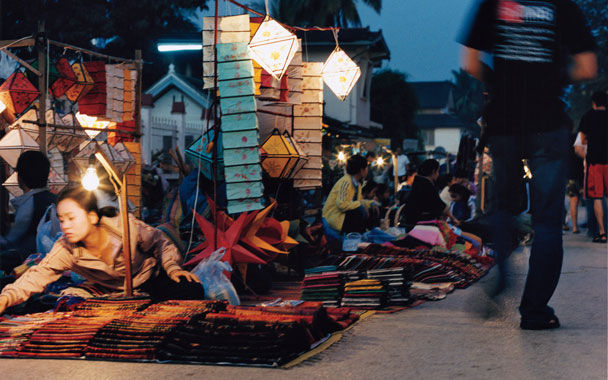Riding a tuk-tuk down a bumpy road through the last swirls of morning Mekong fog, we were off to the Phosy market. Dith, who like many Laotians goes by his first name only, led his collection of would-be cooks past an orgy of Luang Prabang eats. The souvenir stand sold riverweed sheets dappled with sesame and chile. Mounds of red-, white-, and plum-colored rice reflected not only origin but also harvesttime. That beautiful magenta paste in a pack? Pickled fish roe. The little bags of brown liquid? Buffalo bile, a bitter ingredient that gets added to minced-meat salad. Dith knew everything there—the myriad buffalo skins, paddy herbs, pickled bamboo, sour Laotian tamarind, dried buffalo lung, pork floss (dried pork in the shape and consistency of floss), and sticks of mouth-numbing chile wood used only in the north—because he grew up here. He learned by watching his mother in the kitchen. He teaches what she taught him. And that’s key to the Tamarind school’s technique: nothing pretentious, everything frank and friendly, in typical Laotian style. Dith bought our class a bamboo tube of grubs, which he later fried for our dessert. He offered buffalo stomach to anyone inclined to try it. No takers there, but the sweet coconut pudding got rave reviews. We passed a tray of pigs’ heads, and the Canadian vegetarian among us winced, but she needn’t have worried: Tofu and vegetables would greet her at the Tamarind table, and not a speck of flesh would cross her hands. (This was something distinctly at odds with Laotian culture. “One hundred percent, we are meat-eating,” Tamarind founder Joy Ngueamboupha remarked of his country.)
The classroom kitchen overlooks the drowsy Nam Khan River. Neophytes—seven of us—cooked over a sputtering fire on a wooden floor, just as village mothers do. We pounded grilled tomatoes with garlic and green chiles into fiery salsas, elbowing for space in the cramped quarters. Fish caught that morning was steamed in banana leaves with garlic, onion, and dill. Lemongrass stalks were stuffed with minced chicken and herbs—the instructions called for no fewer than nine bunches of cilantro. (What makes Laotian food different from Thai food? More herbs, more bitter, less sweet, our teachers said.) A basket of glutinous rice steamed on a separate brazier. Sticky rice is the key to Laotian identity and a critical accompaniment to any soup, stew, or chutney. These were all traditional dishes, yet having written recipes in our hands was unusual, as Laotians rarely cook from a book. They use their eyes, their stomachs, and their hearts; creating from necessity by using what is growing today. This is how Joy learned as a youngster, foraging to help scrounge up dinner. Years later, he and his Australian partner, Caroline Gaylard, opened their restaurant and school to help demystify this pragmatic cuisine. You don’t just book a class with Joy and Caroline, you go home to a family kitchen. You need know nothing of the mortar and pestle or the bamboo steamer to enroll. Come lunchtime, though, you’ll be forming sticky-rice balls between your fingers—and contemplating a dip in that languid river. (011-856-20-777-0484; tamarindlaos.com; $20 per day, including lunch)
What I Learned
That Laotian cuisine, most of which is usually kept away from tourists, prizes bitterness as healthful.
Biggest Surprise
I’m a garlic fiend, but even my husband noted the aroma that lingered two days after my session with Laotian tomato salsa.
Before You Go
Embrace the Laotian sense of time and hospitality: Things happen when they happen. Life is casual. Have fun with it.
Where to Stay
In the heart of the UNESCO World Heritage district, Lotus Villa (011-856-20-529-5499; lotusvillalaos.com; from $63) is a modern take on old colonial architecture.




 Pinterest
Pinterest






